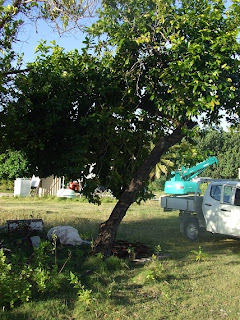Although a recently established property Mike’s yard had a few stories to tell as far as growing vegetables. A number of the vegetables he has grown have resulted in bumper crops and a good amount of produce for the kitchen. Like other good gardens he had plenty of sun on most of his garden.
 |
| Rockmelon was a big producer last season |
Barrels in Mikes’ front yard had been very successful supplying him with lots of rock melons, recently and Passionfruit last year but unfortunately those plant met an untimely death – possibly from too much soluble fertiliser.
Mike had used lots of seaweed and organic matter in his pots and about a 50/50 mix of organic matter and sand. He did not find Casuarina needs to be dramatically effective - unlike Geoff.
He used slow release fertiliser quite successfully on his trees and plants in pots.
Some pots were set up almost like wicking beds, where they were essentially sitting in a well that didn’t let the water level get too high and a hole punched in the side of the box for it the water level got too high. Originally this was to try to cater for hot weather as the plants were drying out too quickly.
 |
| The hydro setup - the large tank pictured was the most expensive item |
Mikes Hydroponic setup was quite successful and he had got lots of tomatoes, lettuce and cucumber and Chinese greens, parsley and rocket. Mike had various kinds f hydroponics set up but overall it set him back about $700 in set up costs and nutrients. Mosquitoes were a problem that had to be a addressed in one of the hydro systems where water sat in the system rather than draining away at night.
Mike had plants growing in cement pots placed on the ground with gravel on the surface and these included some of the best Parsley we had seen so far as well as sage!!, lavender (lovely smell to bring back memories) and Garlic chives.
 |
| herbs in cement pots with gravel mulch |
Mike had a very successful Sweet potato crop on an area that had lots of buried scraps and organic matter.. I think the organic matter was buried rather deeply then more soil placed on top. Originally this area was to be for a Banana circle but the windy site proved too much for bananas and they burned off with the salt.
What proved to be too much for the bananas was quite ok for the figs. The figs looked great and had benefited from the application of slow release fertiliser. Figs should produce 2 crops a year in the tropics as should mulberries.
Rats were quite a problem with eating produce and Mike trapped to reduce them. They were a particular problem with Paw paw and tomatoes.
Mike has had big crops of eggplants both in hydroponics and large pots. He says he hand pollinated them so perhaps that is the key to his success, as many other people had great eggplants but no fruit. Mike also used blood and bone but recommended one brand that had trace elements added.
Snake beans were also a high producing successful crop.
Seasonal recommendations
Mike said that he had most success with planting from June onwards which meant that there was less heavy rain and pests.






























